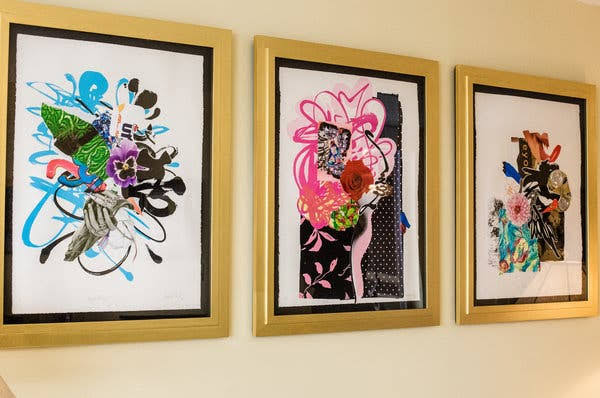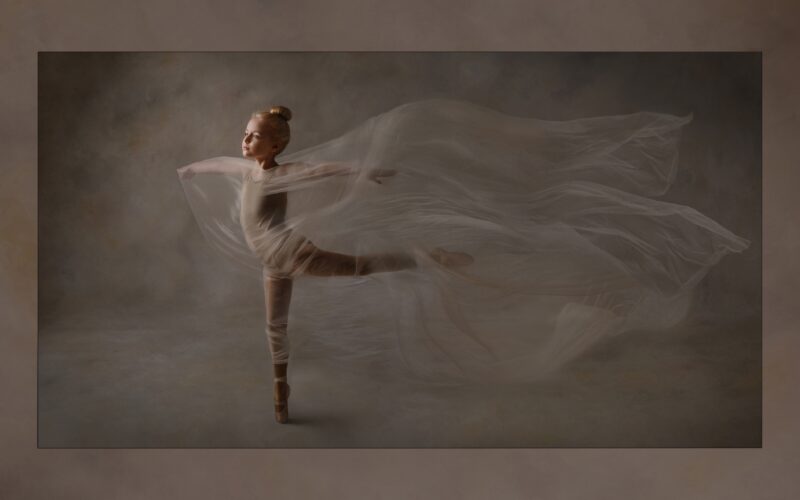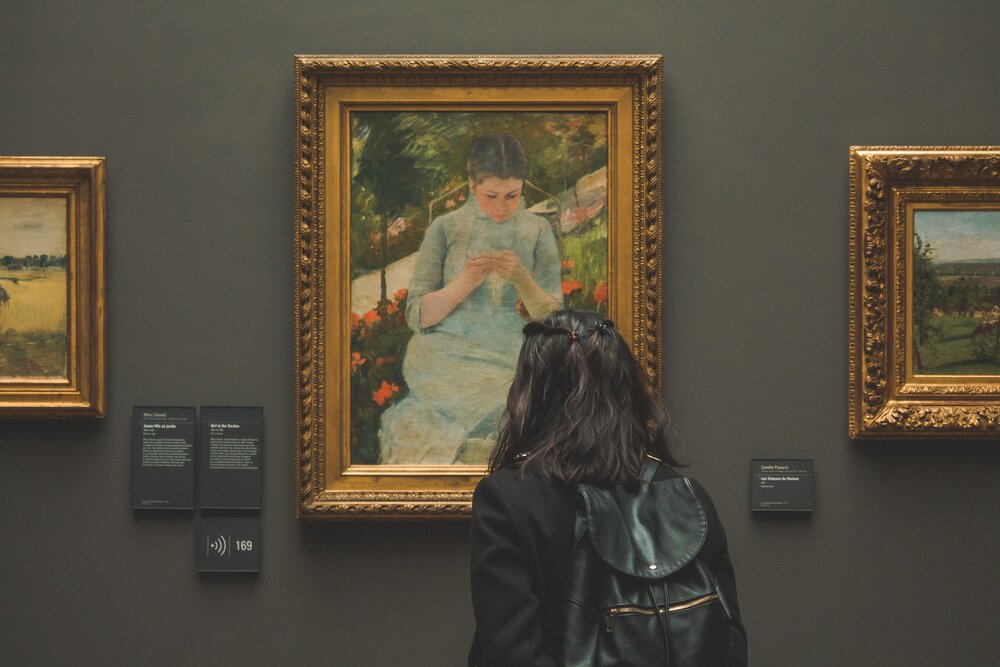
How to successfully create a mix of artwork styles on your gallery walls


Have you ever felt overwhelmed when choosing artwork? Perhaps you’ve pondered over the arrangement, wondered about the right frame styles, debated between matted or full-bleed prints, or fretted about art sizes – we’ve all been there. It can seem like a daunting puzzle, but we’re here to simplify the process.
In this blog, we’ve unraveled the mysteries of art mixing, breaking it down into manageable steps that anyone can follow. The goal is to make it a smooth and enjoyable experience every single time you curate your wall. Whether you’re a seasoned art collector looking to add new dimensions to your collection or someone just beginning to explore the art world, our tips and tricks are designed to add value to your journey.
Imagine being able to effortlessly blend different art styles to create a visually captivating masterpiece that reflects your unique taste and personality. It’s not about getting everything “right” – it’s about infusing your space with art that speaks to you. So, wave goodbye to the confusion and hesitation, and get ready to transform your space with confidence and creativity.
What are the different types of art?
Art styles give us a diverse palette to work with, and knowing a bit about them can greatly enhance your ability to create a visually appealing gallery wall.
Traditional art styles have a rich history, often rooted in classical and historical themes. Think of Baroque’s opulence, Rococo’s delicacy, the timeless beauty of the Renaissance, or the passionate expression of Romanticism. These styles follow established artistic rules and techniques, and understanding them can help you appreciate their beauty.
On the flip side, we have the world of Modern art, which emerged in the late 19th and early 20th centuries. Modern styles, like Cubism, Futurism, Abstract Expressionism, and Pop Art, break away from tradition, embracing new ideas and techniques that challenge the norm.
Contemporary art, on the other hand, is what’s happening right now. It’s a dynamic world filled with diversity and experimentation. Styles like Installation art, Performance art, and New Media art push boundaries and redefine what art can be in our time.
With a grasp of different art styles, you can now start mixing and matching to craft to create a truly unique and personalized space.
How to mix and match different art styles
Start with a unifying theme:

Creating a gallery wall that seamlessly combines various art styles begins with a unifying theme. Think of this theme as the thread that ties your artwork together. It could be a color scheme, a particular subject, an emotion, or even a concept. The theme provides a strong foundation upon which you can build your display.
For example, if you love the tranquility of nature, you might choose a nature-themed gallery wall. This could encompass traditional landscapes alongside contemporary nature-inspired pieces. The shared theme, nature, helps to bridge the gap between different styles, creating a cohesive and visually pleasing arrangement.
So, before you start arranging your art, think about the underlying theme that connects with you. It will guide your choices and ensure that your gallery wall tells a meaningful and harmonious story.
Framing and matting

When you’re mixing and matching art styles and prints, the choice of frames and matting can have a big impact on how well everything comes together. It’s like choosing the right frame for a picture – it enhances and completes the artwork.
Here’s the trick: make sure your framing and matting choices complement the artwork and connect everything visually. You can go for a consistent framing style for all your prints if you want a more uniform and tidy look. This way, all the art pieces share a common thread and look like they belong together.
On the other hand, if you’re into a more eclectic and varied vibe, you can mix and match different frame styles. This approach adds a touch of uniqueness to your gallery wall. Imagine a mix of classic wooden frames with some sleek metallic ones, or perhaps a mix of black and white frames with a pop of colorful ones. It’s like adding spices to a recipe – a little variety can make it more interesting.
Select a focal point

When you’re mixing various art styles and prints, having a focal point is a smart move. Think of it as the star of the show that grabs your attention and brings the whole composition together.
Your focal point can be a large-scale print or artwork that commands the spotlight, or it could be that one-of-a-kind piece that’s truly eye-catching and stands out from the rest of your collection.
Just like in a story, where there’s a central character or a pivotal moment, your gallery wall benefits from a focal point that helps guide the eye and anchors the entire composition. It’s like a friendly guide showing you around an art exhibition, making sure you don’t miss the highlights.
So, when you’re arranging your wall, pick one special piece that takes center stage. It could be something you adore or something with a personal connection. By doing this, you’ll add a touch of organization and direction to your diverse collection, making your gallery wall more engaging and visually appealing.
Play with various sizes and scales

Here’s where the fun begins! Experimenting with different sizes and scales of artwork can bring life and energy to your gallery wall. It’s like playing with puzzle pieces of various shapes and sizes, fitting them together to create something truly captivating.
You can try grouping smaller prints together, just like forming a tight-knit squad. When they come together, they can create the illusion of a larger, more prominent composition. It’s like teamwork in art, with each piece playing its part to form a visually engaging whole.
On the flip side, mixing larger prints with smaller ones is like adding layers and textures to your arrangement. It’s a bit like creating a beautiful mosaic where each piece, regardless of size, adds a unique touch. The interplay of different scales adds depth and visual interest to your gallery wall.
So, don’t be afraid to mix it up. Think of it as a visual adventure where you’re the artist, and your wall is your canvas. By playing around with sizes and scales, you can create a dynamic and visually captivating composition that tells a story unique to you.
Keep a mix of mediums and textures

Diversity is the name of the game when it comes to creating a captivating gallery wall. Mixing and matching different mediums and textures is like adding a dash of spice to your favorite dish – it brings out a unique flavor that tantalizes the senses.
Start by considering a blend of art mediums. You can combine paintings with photographs, or even incorporate sculptures or textile art. The interaction between these different mediums creates a visually stimulating experience. It’s as if you’re telling a story through various artistic languages, making your gallery wall a feast for the eyes.
Texture is another secret ingredient. Think about how different textures can add depth and character to your display. You might have a smooth, glossy painting beside a textured, three-dimensional sculpture. The contrast in texture adds a tactile and visual dimension to your wall, making it more engaging.
So, use a mix of mediums and textures as a way to add richness and depth to your gallery wall. By doing so, you’ll elevate your art collection, creating a space that’s not only visually appealing but also filled with stories waiting to be discovered. It’s art in its most diverse and delightful form.
In conclusion, the art of mixing and matching different styles and prints is like crafting a symphony of self-expression. By following the tips we’ve explored, you can transform your space into a gallery of your own making.
Art is about storytelling, and your gallery wall tells a narrative of who you are, where you’ve been, and where you’re going. So, let your imagination soar, your creativity flow, and your walls become a canvas for self-expression. Whether you aim for a harmonious blend or a vibrant clash of styles, the key is to create a space that resonates with you.

















Comments 18